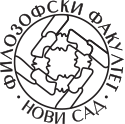HUNNIA ÉS PANNÓNIA KÖZÖTT
Absztrakt
A 2010-es évek második felének szerb irodalomtudományában a Miroslav Krleža életműve iránti érdeklődést a Gradac című folyóirat tematikus száma mellett a Krležát több évtizede kutató horvát tudós és lexikográfus, Vlaho Bogišić 2016-ban Újvidéken megvédett doktori értekezése jelzi. Bogišić disszertációjában kifejti, Krleža szerb írónak is tekinthető, hiszen műveivel, pozíciójával és kapcsolataival olyan befolyást gyakorolt a szerb irodalomra, melyet lehetetlen figyelmen kívül hagyni. Bori Imre 1976-os Krleža-monográfiájában pontosan meghatározza az életmű magyar vonatkozásait: a Krleža eszmei fordulatát elbeszélő Hodorlahomor, a nagy című novellát Ady Ős-Kaján-képzetével hozza összefüggésbe; az 1930-as Ady-esszét pedig azok közé az egykorú írások közé sorolja be, melyekben Krleža irodalomszemléletét fogalmazta meg. A dolgozat egyfelől Bori Imre monográfiájának gondolatmenetét mutatja be és értékeli, másfelől azt bizonyítja, hogy a horvát író művének magyar elemei nem tárgyalhatók kizárólag a Monarchia-irodalom keretében, a Zára aranya és ezüstje című esszében a mediterrán térség harmadik komponenséről megfogalmazott elképzelés ugyanis a múlt század hatvanas éveinek fiatal vajdasági irodalmában közvetlen visszhangra talált.
Hivatkozások
Bányai János. 1978. Adat Krleža Ady-értelmezéséhez. Híd 42 (12): 1493‒1499. Bori Imre. 1976. Miroslav Krleža . Újvidék: Forum.
Biti, Vladimir. 2018. The Politics of Remembrence: Walter Benjamin’s Childhood Around 1900 and Miroslav Krleža’s A Childhood in Agram in 1902‒1903. In Attached to Dispossesion: Sacrificial Narratives in Post-Imperial Europe . 235‒276. Leiden‒Boston: Brill .
Bogišić, Vlaho. 2016. Miroslav Krleža u srpskoj književnosti: Problem književnosti kao identiteta u srpskoj i hrvatskoj kulturi XX stoljeća. Doktorska disertacija. Novi Sad: Filozofski fakultet. Rukopis.
Brabanović, Predrag. 2016. Avangarda Krležiana ‒ pismo ne o avangardi. Zagreb: Naklada Jesenski i Turk i Arkzin.
Fejtő Ferenc. 1989. Érzelmes utazás . Budapest: Magvető.
Krleža, Miroslav. 1952. Djetinjstvo u Agramu (1902‒1903) . Zagreb: Državno izdavačko poduzeće.
Krlezsa, Miroszláv. 1957. Ady Endre, a magyar lírikus. Híd 21 (1): 8‒19.
Krleža, Miroslav 1961. Madžarski lirik Andrija Ady. In Eseji: Knjiga prva, 95‒122. Zagreb: Zora.
Krleža, Miroslav. 1964. Filip Latinovicz hazatérése . Ford. Illés Sándor. Újvidék: Forum.
Krleža, Miroslav. 1965. Agrami gyermekkorom 1902‒1903. Ford. Ács Károly. In Versek: Emlékiratok. 229‒294. Újvidék: Forum.
Krleža, Miroslav. 2002. Zára aranya és ezüstje. Részlet. Ford. Utasi Csilla. Műhely 25 (4): 39‒44.
Lőkös István. 1990. Az élménytől a recepcióig: Krleža és Ady viszonyáról. Tiszatáj (10): 62‒73.
Lőkös István. 2018. Miroslav Krleža 1922-es torzképe a magyar irodalomról. Magyar Szemle XXVII. (5‒6). http://www.magyarszemle.hu/cikk/20180622_miroslav_krle_a_1922-es_torzkepe_a_magyar_irodalomrol (2020. jan. 3.)
Németh László. 1940. Krlezsa Adyról. Kelet Népe (1.9): 11‒12.
Tolnai Ottó. 2001. Ahogy. In Balkáni babér. 99‒118. Pécs: Jelenkor.








